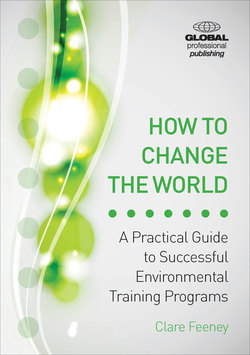Читать книгу How to Change the World - Clare Feeney - Страница 11
На сайте Литреса книга снята с продажи.
ОглавлениеAcknowledgements
Grateful acknowledgement is given for the inspiration and support I and my co-trainer, Brian Handyside of Erosion Management Ltd have received from the leaders of the Erosion and Sediment Control Program run by the Auckland Regional Council and its successor, the Auckland Council: Kerry Connolly, Mark Cleaver, Earl Shaver, Graeme Ridley, Paul Metcalf, Mike Dunphy and Roger Bannister, as well as Stormwater Education and Community Programmes Advisor Marcus Ballantyne and current Team Leader Andrea Horton.
Permission is also gratefully acknowledged from Water New Zealand to update a 1999 paper entitled Training – building relationships for improved environmental outcomes, authored by Clare Feeney, Graeme Ridley, Frances Graham, Kevan Brian and Patricia Blütner. This paper was presented to the 1999 Conference in Christchurch New Zealand, themed ‘Valuing our environment – dollars and sense’. It won Third Prize in the Paper of the Year category, the first time a non-technical paper had received such an award in the association’s then 40 years of history.
An updated version of that paper was presented in abbreviated form at the 33rd International Association for Hydro-Environment Engineering and Research (IAHR) Biennial Congress in Vancouver August 9-14 2009 on the theme of ‘Water Engineering for a Sustainable Environment’. I thank the 2009 conference organizers for the opportunity to enlarge on the thinking in the original paper and Roger Bannister for his inspirational input to the paper.
Brian Handyside and I have learned heaps and had a wonderful time working with David Hewson, Kate Lewis, Donna Woodley, Jocelyn Muller and other staff of Environment Canterbury and other Councils in New Zealand, including Northland, Bay of Plenty, Waikato, Wellington and Dunedin.
I have also learned a great deal from the many trainers who generously present every month at meetings of the New Zealand Association of Training and Development – thank you to all these experts.
A big thank you to Jay Wilson of the City of Charlotte in North Carolina for allowing me to cite his erosion and sediment control training program as a detailed case study.
More thanks to the people who allowed me to cite their work as other case studies and advice and gave very helpful feedback, including Michael Lindgreen, Shona Myers, Tim Lovegrove, Kate Lewis, Sian Carvell, Craig Pauling, John Stewart, Catherine Stephenson, Paul Mannix, Earl Shaver, Mike Frankcombe, Alastair Rylatt, Beryl Oldham, Ed Bernacki and more.
Thanks also to Johann Bernhardt and Eddie van Uden for allowing me to tell in Chapter 5 the story of their wonderful way of creating a test that everyone will pass.
Particular thanks go to Nicola Goodenough, Senior Advisor Corporate Affairs at Transfield Services, and to then employee Amanda Davies for helping me flesh out the case study in Chapter 6 on language barriers, for allowing the publication of this valuable information. Find out more at http://www.transfieldservices.com/ and http:// www.transfieldservices.com/page/Regions/ANZ/. Thanks also to Hugh Pollock of Transfield Services (who worked on the project with Amanda) for sending me the link to the excellent article by Chris Poole. Contact details: Amanda Davies, Principal, URS New Zealand Limited. PO Box 13131, Tauranga, New Zealand 3141. Email Amanda.davies@urs.com. Find out more at http//www.urscorp.co.nz/. Hugh Pollock, Environmental, Health & Safety Manager Roads – New Zealand, Transfield Services Limited, PO Box 48, Whangarei, New Zealand 0140. Email mailto:pollockh@transfieldservices.com.
As always, thanks to my incredibly kind, knowledgeable and inspirational mentor, Ann Andrews of The Corporate Toolbox.
And, of course, to all the trainees who have attended our workshops over the years and from whom I have learned such a lot. Without trainees, no training!
